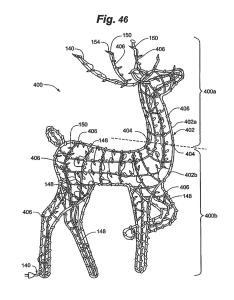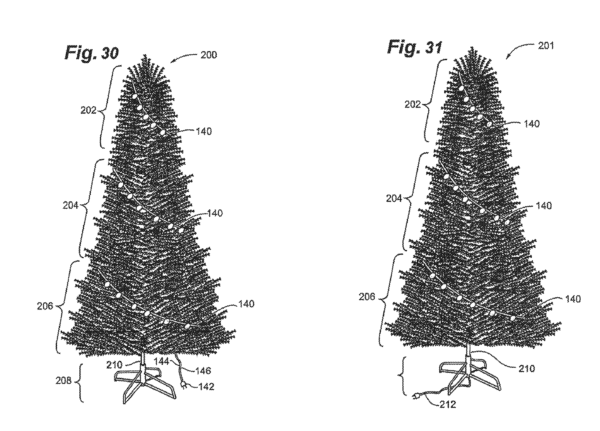by Dennis Crouch
The Federal Circuit’s April 12, 2022 decision in Everstar Merchandise narrowly focuses on PTAB trial procedure.[1] And, as a non-precedential opinion, it lacks weight. Still, the case is important because of the fabulous Christmas Theme drawings found in the patent-at-issue.[2]

Willis Electric and Everstar compete in the decorative lighting marketplace. In 2019, Everstar petitioned for post-grant review (PGR) of a Willis patent covering a “strength-enhanced, net-like decorative lighting structure.”[3]
These nets need to be strong enough so that they do not fall apart. The prior art solutions of twisted-pair, thicker wires, and extra support wires solved the problem but had drawbacks of cost, bulk, and weight. Willis improved upon the prior art with a single wire with internally reinforced strands and an outer insulating layer. The obviousness case presented two references whose combination taught all of the claim elements: Kumada disclosed a net design; Debladis disclosed the internally reinforced wire.[4] Although the PTAB initially granted the PGR petition, it eventually sided with the patentee—holding that a person of skill in the art would not have been motivated to combine the references.

During briefing, the patent challenger argued that cost reduction provided a motivation to combine the references. This seemed like a natural argument because cost reduction is a stated reason for the Willis invention at issue as well as a stated concern in both prior art references. In response, the patentee got technical and provided evidence that the proffered combination would not necessarily reduce cost. A cost reduction might come from reducing copper content, but the original petition did not particularly make the reduced-copper argument. In a reply brief, the challenger then made the link—arguing that the combination “would reduce the amount of total copper [and therefore] would reduce the cost of the system.”
The Board eventually refused to consider the particularized cost-reduction argument since it was not raised in the initial petition. The result then was a holding that the challenger had not met its burden of proving the claims obvious. On appeal, the Federal Circuit has vacated and remanded.
The Federal Circuit agreed that the initial petition controls the AIA trial, and that initial petition must identify the particular evidence that supports the grounds for challenging each claim. Here, though the court distinguished between an “entirely new rationale” (which is prohibited) and responsively elaborating on prior arguments (which is allowed). Here, the court concluded that the petition had sufficiently raised the cost-reduction argument and tied it particularly to the prior art references. In its conclusions though, the court referenced materials beyond the initial petition itself by further noting that cost reduction was discussed in the institution decision, was the subject of expert testimony, and was briefed on the merits. Those actions together constituted a “developed record” that allows for a “fair extension” of the original arguments. Further, “[a]ny ambiguity as to whether a reply constitutes a new argument is eliminated when the reply is a legitimate reply to arguments introduced in a patent owner’s response or the Board’s institution determination.”[5]